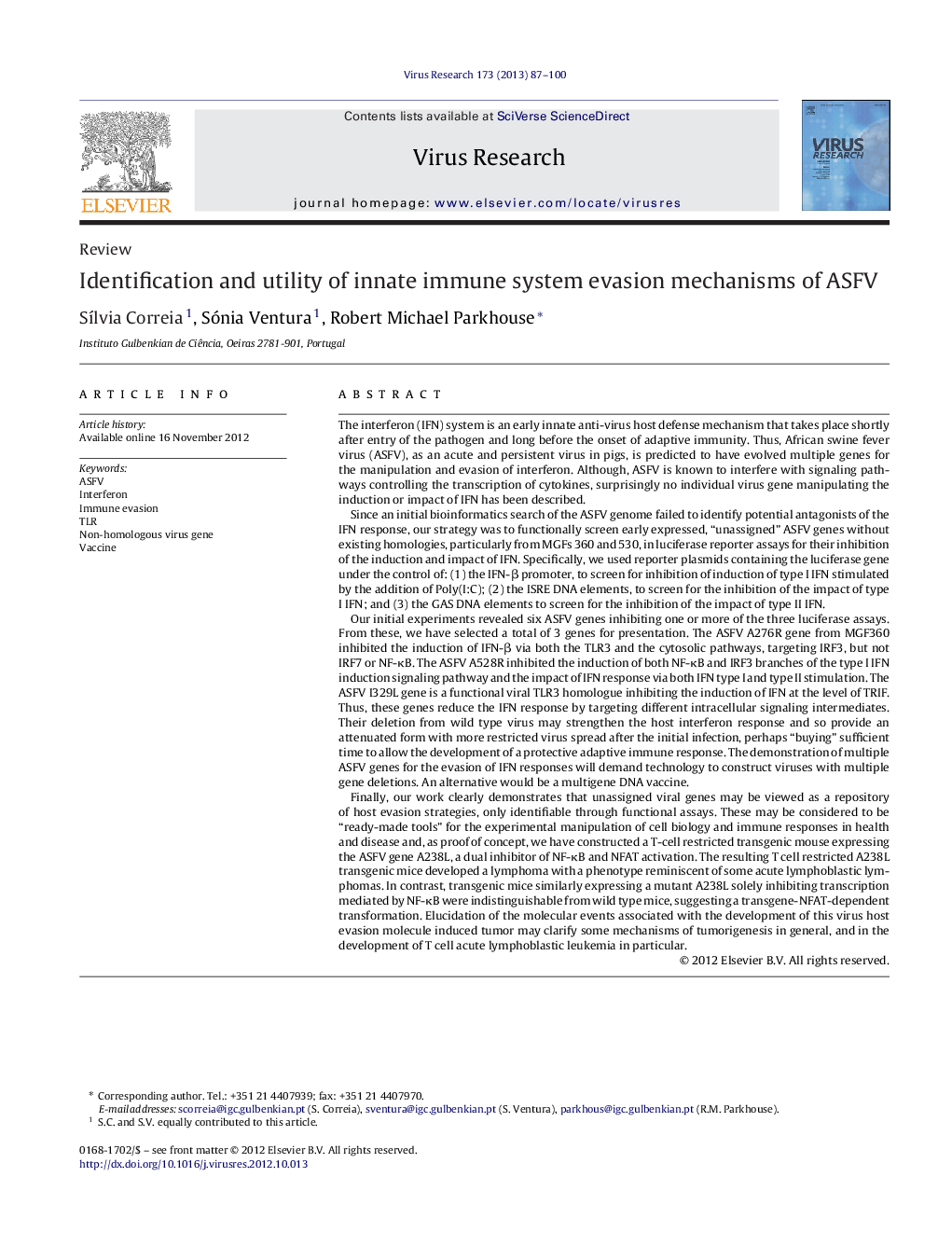| کد مقاله | کد نشریه | سال انتشار | مقاله انگلیسی | نسخه تمام متن |
|---|---|---|---|---|
| 3428794 | 1228227 | 2013 | 14 صفحه PDF | دانلود رایگان |

The interferon (IFN) system is an early innate anti-virus host defense mechanism that takes place shortly after entry of the pathogen and long before the onset of adaptive immunity. Thus, African swine fever virus (ASFV), as an acute and persistent virus in pigs, is predicted to have evolved multiple genes for the manipulation and evasion of interferon. Although, ASFV is known to interfere with signaling pathways controlling the transcription of cytokines, surprisingly no individual virus gene manipulating the induction or impact of IFN has been described.Since an initial bioinformatics search of the ASFV genome failed to identify potential antagonists of the IFN response, our strategy was to functionally screen early expressed, “unassigned” ASFV genes without existing homologies, particularly from MGFs 360 and 530, in luciferase reporter assays for their inhibition of the induction and impact of IFN. Specifically, we used reporter plasmids containing the luciferase gene under the control of: (1) the IFN-β promoter, to screen for inhibition of induction of type I IFN stimulated by the addition of Poly(I:C); (2) the ISRE DNA elements, to screen for the inhibition of the impact of type I IFN; and (3) the GAS DNA elements to screen for the inhibition of the impact of type II IFN.Our initial experiments revealed six ASFV genes inhibiting one or more of the three luciferase assays. From these, we have selected a total of 3 genes for presentation. The ASFV A276R gene from MGF360 inhibited the induction of IFN-β via both the TLR3 and the cytosolic pathways, targeting IRF3, but not IRF7 or NF-κB. The ASFV A528R inhibited the induction of both NF-κB and IRF3 branches of the type I IFN induction signaling pathway and the impact of IFN response via both IFN type I and type II stimulation. The ASFV I329L gene is a functional viral TLR3 homologue inhibiting the induction of IFN at the level of TRIF. Thus, these genes reduce the IFN response by targeting different intracellular signaling intermediates. Their deletion from wild type virus may strengthen the host interferon response and so provide an attenuated form with more restricted virus spread after the initial infection, perhaps “buying” sufficient time to allow the development of a protective adaptive immune response. The demonstration of multiple ASFV genes for the evasion of IFN responses will demand technology to construct viruses with multiple gene deletions. An alternative would be a multigene DNA vaccine.Finally, our work clearly demonstrates that unassigned viral genes may be viewed as a repository of host evasion strategies, only identifiable through functional assays. These may be considered to be “ready-made tools” for the experimental manipulation of cell biology and immune responses in health and disease and, as proof of concept, we have constructed a T-cell restricted transgenic mouse expressing the ASFV gene A238L, a dual inhibitor of NF-κB and NFAT activation. The resulting T cell restricted A238L transgenic mice developed a lymphoma with a phenotype reminiscent of some acute lymphoblastic lymphomas. In contrast, transgenic mice similarly expressing a mutant A238L solely inhibiting transcription mediated by NF-κB were indistinguishable from wild type mice, suggesting a transgene-NFAT-dependent transformation. Elucidation of the molecular events associated with the development of this virus host evasion molecule induced tumor may clarify some mechanisms of tumorigenesis in general, and in the development of T cell acute lymphoblastic leukemia in particular.
► Non-homologous ASFV genes were functionally screened for inhibition of IFN responses.
► 6 non-homologous ASFV genes inhibited the induction and/or impact of IFN.
► The ASFV “anti-IFN” genes target different intracellular signaling intermediates.
► A viral TLR3 antagonist targeting TRIF was identified.
► T-cell restricted transgenic expression of ASFV gene A238L induced a T-cell lymphoma.
Journal: Virus Research - Volume 173, Issue 1, April 2013, Pages 87–100